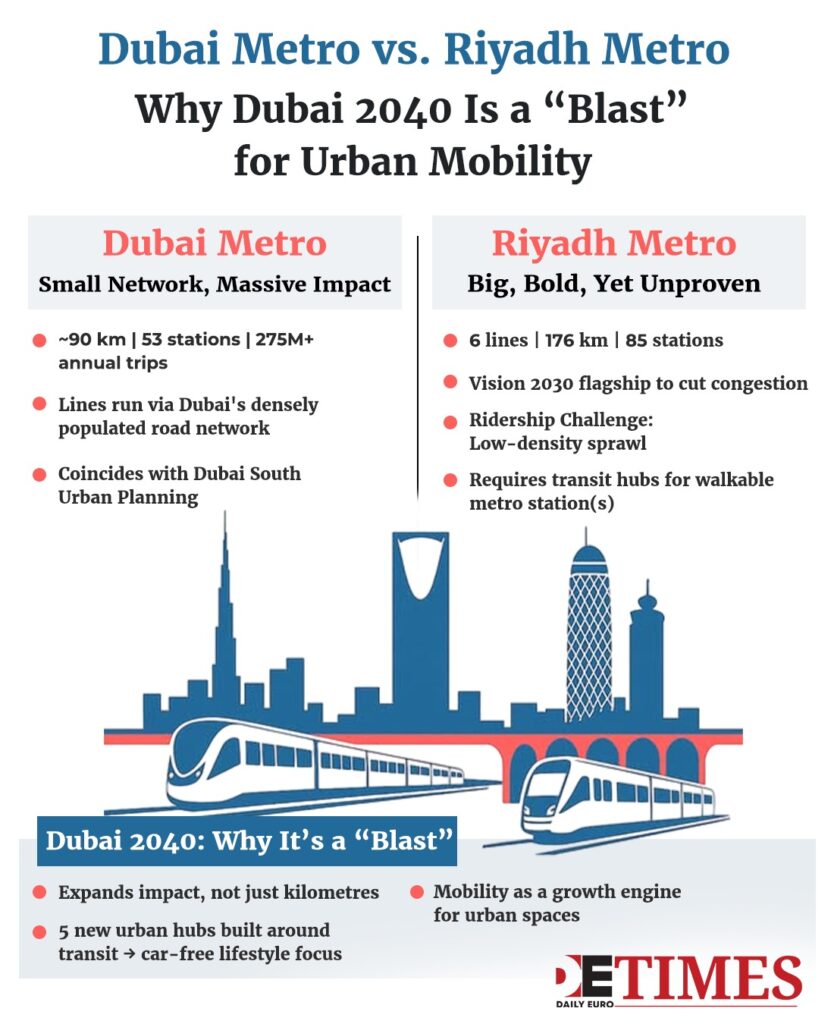The Dubai Metro and Riyadh Metro are the region’s largest projects, symbolising the transition from car dependence to sustainable transportation. Riyadh leads the way in scale: six lines, totaling 176 km in length and 85 stations, cover key areas of the Saudi Arabian capital.
This ambitious infrastructure project aims to reduce traffic congestion and create a modern mobility environment. However, the success of a transportation system is measured not only by length but also by the efficiency of its use and the cities’ marketing strategy.
On that note, Dubai wins everytime.
Dubai: Compactness, Integration, and Efficiency
With a length of approximately 90 kilometres and 53 metro stations, Dubai boasts impressive public engagement: over 275 million trips per year.
The city has achieved this through the thoughtful placement of stations: lines pass through business, residential, and tourist districts: Downtown, Dubai Marina, Business Bay, and the airport.
As a result, the metro has become more than just a means of transportation; it is an integral part of everyday life, increasing mobility and reducing traffic congestion. This level of integration makes each station an important economic and social hub.
Dubai 2040: Future Transportation as a Driver of Investment
The Dubai 2040 Urban Master Plan takes public transportation to the next level.
It envisions not only expanding the metro but also creating five "urban hubs" — zones where housing, business, and leisure are concentrated around transportation hubs as Dubai's growth moves south to Dubai South, DP World's Jebel Ali, and of course the new Dubai Maktoum International Airport.
The goal is to make car-free travel the norm, increase the share of public transportation, and strengthen Dubai’s status as a global hub for investment and innovation.
Experts call this plan “explosive expansion” not in terms of kilometres, but in terms of the quality of urban life and transport accessibility.

Investment Context: Why Dubai Wins?
Dubai’s Metro is closely tied to its foreign direct investment model. The city has long been a financial and logistics hub, attracting international companies and investors. Metro stations increase property values and stimulate the development of office centers and retail space, making transportation not just social infrastructure but investment infrastructure.
Furthermore, the system is regulated by a single authority (RTA), ensuring transparency and predictability for investors: an advantage Riyadh has not yet achieved.
Riyadh: A Bold Future, but a Long Road
The Riyadh Metro is a key element of the Vision 2030 plan. It aims to reduce dependence on private transport and connect remote areas… something Dubai’s Metro lacks quite noticeably in residential areas east of the main CBD: JVC, Emirates Hills, and Al Barsha in particular.
However, the project faces many challenges: low-density urban development and car-oriented habits of local residents. For the system to operate at its full potential, the development of areas around stations (Transit-Oriented Development) and the creation of pedestrian zones and commercial clusters are essential for financial viability and any multiplier effect in real estate and other lucrative markets.
The potential is enormous, but implementation will take time and a change in urban culture as the metro reaches residential areas in scale yet fails to integrate transit between residential neighbourhoods and stations.
Riyadh Doesn’t Go the Extra Mile Yet
Based on length, Riyadh wins. But in terms of integration, passenger traffic, economic impact, and urban design, Dubai leads the way.
The Dubai 2040 plan promises to transform urban mobility into a development engine, connecting transportation, urban planning, and investment into a unified ecosystem.
In this sense, Dubai is setting an example of how a metro can become more than just a mode of transportation, but a strategic tool for growth adapted to it’s residents and of course the FDI that underpins Riyadh and Dubai’s growth as financial and tech hubs.
Read the Latest Articles on DET!
When the Angels Return: How Victoria’s Secret is Shocking the New Era of Beauty
From Sweden to Türkiye: The Stark Gender Divide in Unpaid Work
Social Capital Lives On: The Story of Germany and Russia





